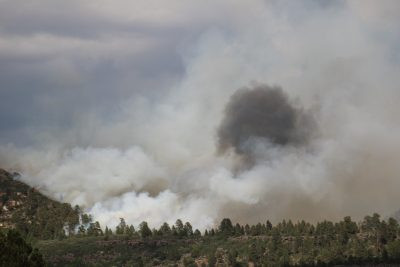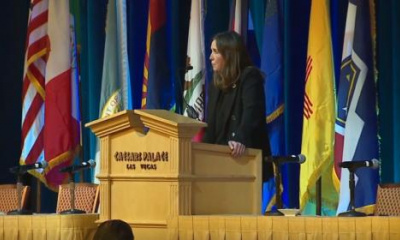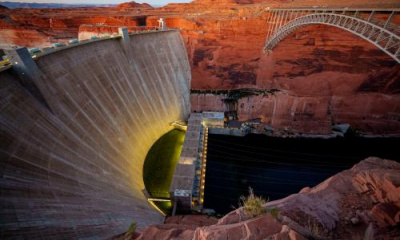ST. GEORGE — Need another reason to avoid starting a wildfire? The danger of wildfires goes beyond turning forests and homes to ash; they also pose a risk to area watersheds, including the potential to contaminate a local water supply.
“It’s something we’re always concerned about,” Zach Renstrom, general manager of the Washington County Water Conservancy, recently told St. George News.
So far this year and in recent years, wildfires in Washington County have not grown to a size that would greatly impact the Virgin River watershed. However, that situation can change overnight and is just one of the many scenarios local water managers monitor as part of their mission to deliver clean drinking water to the majority of county residents.
“The wildfires that make me nervous are those massive ones that would cover hundreds of square miles of land,” Renstrom said. “They would have a huge detrimental effect on our water system if that were to happen.”
Unlike natural events such as earthquakes, which county officials can only respond to in the aftermath, the circumstances surrounding wildfires and accompanying watershed damage are preventable, Renstrom said.
But what are these impacts, and how would they affect a water supply like the Virgin River and the people who rely on it? Why is it such a concern for local water officials, as well as their state and federal counterparts?
Many issues can arise in the wake of a wildfire, Renstrom said, which include:
Increased erosion and sedimentation: After a wildfire, vegetation that normally stabilizes soil is burned away, leading to increased erosion. This can cause sediment to enter rivers, streams and reservoirs, which can reduce water quality and the storage capacity of reservoirs.
Contamination from ash and debris: Wildfires generate ash and debris, which can be washed into water bodies during rainfall. This can introduce harmful chemicals, such as heavy metals, nutrients and organic pollutants, into the water supply.
Water quality degradation: The influx of ash, debris and sediment can cause a decline in water quality, leading to increased turbidity, higher levels of nutrients (like nitrogen and phosphorus), and the potential for harmful algal blooms that can pose a health threat to humans and prove fatal for their pets.
Changes in water chemistry: Wildfires can alter the chemical composition of water, including changes in pH, increased dissolved organic carbon, and higher concentrations of metals. This can affect aquatic life and complicate water treatment processes.
Increased cost for water treatment: The many changes that can occur to the chemistry of the water, as well as having to deal with increased sediment, ash and debris in the water, make it harder and more expensive to convert it into safe drinking water, Renstrom said.
“It would cost us substantially more money to treat that water, and unfortunately, we’d have to pass that cost onto the average water user,” he added
Hydrophobic soil conditions: Wildfires can cause soils to become hydrophobic (they won’t suck up the water), which can lead to increased surface runoff and reduced water infiltration. This can increase erosion and reduce groundwater recharge.
Flooding and debris flow: The loss of vegetation and the development of hydrophobic soils can increase the risk of flash flooding and debris flows during rainstorms, posing a threat to infrastructure, ecosystems and human safety.
The risk of flooding was highlighted in a recent message from the Utah Department of Emergency Management to property owners. The department warned that the aftermath of a wildfire can create “ideal conditions” for flash floods, which can be common in the wake of such events.
“The increased risk of high-velocity, debris-laden flooding can persist for several years,” the department stated. “Flooding after a fire is often severe as ash and debris can form mudflows that can cause significant damage to homes, properties, communities and recreational areas impacted by fire.”
Because of this threat to homes and other property, state officials encourage property owners to consider getting flood insurance. For detailed flood-after-fire or flood insurance information, visit the Utah Flood Hazards website, floodhazards.utah.gov, or floodsmart.gov.
Long-term changes to hydrology: The loss of vegetation can lead to changes in a watershed’s hydrological cycle, including altered streamflows, reduced groundwater recharge and changes in the timing and volume of runoff. These changes can affect water availability for ecosystems and human use.
Damage to water infrastructure: Wildfires can damage critical water infrastructure, such as reservoirs, dams, pipelines and water treatment facilities. This can disrupt the water supply and require costly repairs.
Increased fire risk in water supply areas: The destruction of vegetation and the accumulation of dry debris can increase the risk of future wildfires, creating a cycle of ongoing impacts on the watershed and water supply.
Ecological impacts: The loss of riparian vegetation and changes to stream habitats can have long-term impacts on aquatic ecosystems, including the loss of fish and other species that depend on clean, stable water environments.
The Virgin River is home to endangered species like the Wouldfin, Virgin River Chub, Southwestern Willow Flycatcher and various other wildlife that are of concern to state and federal officials. In order to help protect these species and their habitat while also balancing the human use of the river, the water district takes part in the Virgin River Program.
“We try to do everything we can to make sure the conditions on the river are such that the endangered fish and other endangered species around the river are protected and thriving,” Renstrom said.
If the situation were to get out of hand, the U.S. Fish and Wildlife Service could take over river management for the benefit and preservation of endangered species over the general use of the river by others, he said.
A word on prevention
Along with following the usual advisories and counsel from fire officials to obey local and regional fire restrictions and use fireworks responsibly, Renstrom added another measure – better forest management.
Forests in the West are overgrown, Renstrom said, adding that he knows federal agents who would love to thin the forests but can’t due to federal regulations. Instead, the forests have been allowed to become increasingly dense and susceptible to so-called “megafires” that have begun to plague the western United States in recent years.
“If we could go in and manage our forests and make them healthy, then we could avoid this problem forever,” Renstrom said, adding that better management would allow more runoff from melting snow in the mountains to reach the river and, eventually, the county reservoirs.








